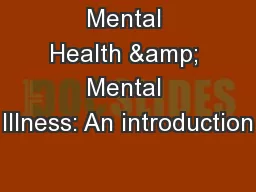PPT-Mental Toughness
Author : tatiana-dople | Published Date : 2017-06-27
Helena Sharpstone and Caryn Skinner The session What is it Whats in it for you to be mentally tough What does it look like Creating the right environment When does
Presentation Embed Code
Download Presentation
Download Presentation The PPT/PDF document "Mental Toughness" is the property of its rightful owner. Permission is granted to download and print the materials on this website for personal, non-commercial use only, and to display it on your personal computer provided you do not modify the materials and that you retain all copyright notices contained in the materials. By downloading content from our website, you accept the terms of this agreement.
Mental Toughness: Transcript
Download Rules Of Document
"Mental Toughness"The content belongs to its owner. You may download and print it for personal use, without modification, and keep all copyright notices. By downloading, you agree to these terms.
Related Documents














